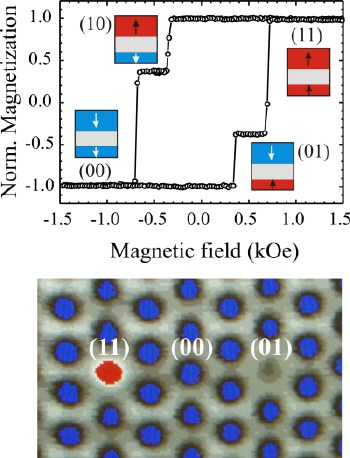Physicists in the US and Germany have reported on a new way to double the storage capacity of magnetic recording devices. The method, which is compatible with standard lithography fabrication techniques, could help overcome the limits of conventional magnetic recording and allow storage densities of 1 terabit (1012) bits per square inch (M Albrecht et al. 2005 J. Appl. Phys. 97 103910). The increase in storage capacity is made possible by combining arrays of magnetic dots with multiple magnetic layers.

Magnetic data storage is rapidly reaching the so-called superparamagnetic limit, beyond which the magnetic domains in conventional recording media become so small that they become unstable. The limit is predicted to occur at storage densities of about 200 gigabits per square inch.
Bruce Terris of the Hitachi San Jose Research Center and colleagues at the University of Konstanz and the BESSY synchrotron in Berlin began by making an array of silicon dioxide pillars. The array had a period of 300 nanometres and the pillars measured 150 nanometres in diameter and 80 nanometres high. Next, they deposited two magnetic layers made from cobalt-palladium onto the pillars, separated by a thick non magnetic spacer layer of palladium.
These two layers have different values for their magnetic coercivity: in other words, the strength of the magnetic field that is needed to reduce the magnetization of the upper magnetic layer to zero differs from that needed to do the same for the lower layer. This means that the magnetizations of the two layers can point in different directions. The end result is that the each pillar gives rise to four different magnetization states, which can be read back separately, thus doubling the storage density of the device (see figure).
The US-German team says that increasing the number of layers will further increase the storage density and it now plans to demonstrate that its technique works with three layers.
“This idea is interesting, particularly as we come to the limits of conventional recording,” says Kevin O’Grady of the University of York in the UK. “If it could work on continuous films then it could be of interest for the near future.”



